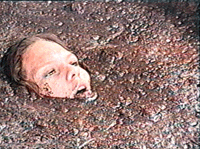Of Note: Scientists Finally Quell My Quicksand Phobia
 It's fair to say that, growing up, I worried more than your average kid. I worried about normal things, like my parents dying. But more than anything, I worried about the impossible: Airplanes falling from the sky and landing on me; my brother getting drafted and shipped off to die in battle at age ten. At one point, thanks to Tarzan, I became acutely phobic of killer bees and man-eating-ants. My parents told me they didn't exist in the US, but I looked at a map and convinced myself that they could easily come from South America to my backyard in Illinois. But my biggest phobia for several years -- one that kept me up at night -- was quicksand.
It's fair to say that, growing up, I worried more than your average kid. I worried about normal things, like my parents dying. But more than anything, I worried about the impossible: Airplanes falling from the sky and landing on me; my brother getting drafted and shipped off to die in battle at age ten. At one point, thanks to Tarzan, I became acutely phobic of killer bees and man-eating-ants. My parents told me they didn't exist in the US, but I looked at a map and convinced myself that they could easily come from South America to my backyard in Illinois. But my biggest phobia for several years -- one that kept me up at night -- was quicksand.My brother and I watched a lot of weird 70s jungle shows -- and played weird jungle video games -- so in my world, people were constantly getting stuck in quicksand. They'd flail around screaming as friends threw them sticks, shirts, whatever -- desperately trying to pull them out -- but nothing ever worked. And it all happened so fast: They were just walking along and suddenly, squish, they're up to their waist, chest, neck, then they're gone. Just like that.
I secretly feared walking in the park down the street from my house because of the quicksand. Today, I know there was no quicksand in Illinois. But as a kid, it seemed an obvious risk: There were vines hanging from trees, there was sand on the trail, it looked just like the woods in the movies -- why wouldn't there be quicksand?
I'd completely forgotten about this old phobia of mine until a few months ago, when I watched Lawrence of Arabia for the first time in years. At what felt like hour six in the movie, there's a graphic scene where a young boy dies in quicksand. At that point, I suddenly remembered my old quicksand fear and thought, See, that's why I live in New York City ... no quicksand!
So all of this is to say, I was very relieved to hear the news yesterday that scientists have reported that quicksand is not, in fact, as dangerous as all the movies make it seem. If you fall into quicksand, instead of being completely consumed by it, you will actually only sink to your waist. Then you float. But you're not exactly homefree: To just pull one leg out of quicksand, their study says, it takes the same amount of force needed to lift a car. Fortunately for all of us, the scientists offer tips for getting out:
"... while the risk of vanishing has apparently evaporated, escaping the muck is still a tough task: ... There are tricks, however. Quicksand is a mixture of fine sand, clay and saltwater. Once perturbed, the mixture transforms from a loose packing of sand on top of water into a dense, liquid soup. Movement by a victim makes things worse.Now, call me crazy, but I'm thinking -- if I'm stuck in quicksand and the only thing that can get me out is some water trickling down my leg, I'd be making more than circular motions, if you know what I mean. But either way, I'm in no hurry to test their theory: They did this reserach using aluminum balls in simulated quicksand. I'll wait until they work it out with actual people in actual quicksand ...
"The higher the stress, the more liquid the quicksand becomes, so movement by a trapped body causes it to sink in deeply," study leader Daniel Bonn of the University of Amsterdam writes in the Sept. 29 issue of the journal Nature. After the mix liquefies, the quicksand splits into a water-rich phase and a sand-rich one. The wet sand sediment becomes so densely packed that it's harder to move than cold molasses. Once the victim's foot becomes stuck in it, the situation is dire ... How to get outBonn and his colleagues found, however, that if a you remain calm, you can actually float your way to safety.
"The researchers simulated a quicksand pit in the lab and placed an aluminum ball of greater density than the quicksand on top of the pit. The ball didn't sink until the researchers began to shake the pit, simulating movement and turning the mixture of sand and water more liquid. When they did this, the ball sank right to the bottom.
But when they used an aluminum ball with a density equal to the human body, which is less than the density of quicksand, they found it impossible to sink the ball, no matter how hard they shook the pit ... The advice : Stay calm and eventually you'll float. Stretch out on your back to increase your surface area and wait until your legs pop free. Bonn also suggests moving your legs around at this point, to stir in water, which will help you float. "You have to introduce water into the sand," Bonn said. "And the easiest way to do that is to make it trickle along your leg into the quicksand, by making a circular motion with your leg."
Labels: Just Plain Silly, Latest Discoveries, Personal Updates, Science: General, Weird Science




